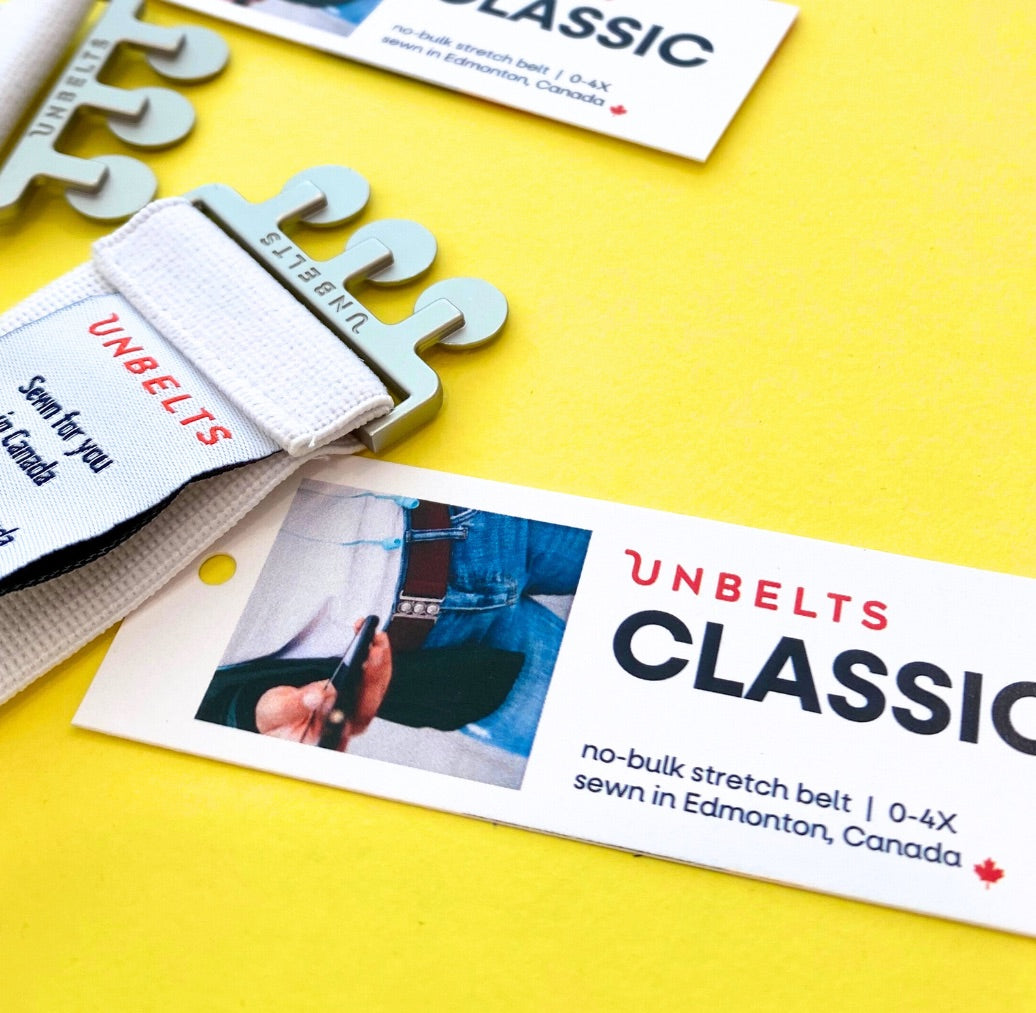
We've moved 100% of our cut-and-sew to Canada. Here's why (it might not be what you think).
Share
Hi! Founder Claire here to tell you: Every Unbelt is now made in Canada.
…and that’s bittersweet.
I started this business in Shanghai back in 2011. I was a bright-eyed twentysomething desperate for her pants to fit and blessed by talented neighbours who were open to part-time sewing gigs. Here's my prototyping set-up and my first hires, all working from a living room:


China’s been my second home since I was a teenager and made my first journey to my paternal grandmother’s homeland. I backpacked there after high school, spent a summer in Shanghai during university, and ended up minoring in Mandarin so I could move back to China after graduation. I ended up living in Shanghai from 2008 to 2014 and met my husband there the same year I started the business.
Over the years, our sewing team evolved from Shanghai neighbours to a small factory just outside the city to Ms. Ou’s factory in south China. We kept each other in business during COVID, and her team has been with us through our best and worst times (read our blog post about that here).
We opened our Edmonton studio in 2017 to complement Ms. Ou’s. We’ve sewn all Intrepids and Kids’ Belts, with Ms. Ou’s team handling Classics. Now, we’re moving Classics to our Edmonton studio, too - and we want you right alongside us as we make this transition, because we need your help.

The easy (but untrue) story to tell about bringing sewing “home” to Edmonton would have to do with a simple (but untrue) binary between offshore vs. inland, junk vs. quality, unethical vs. virtuous. The more complex (and true) story has everything to do with post-COVID logistical necessities, sustainability opportunities, and an honestly pretty painful uprooting of deep ties to partners we really care about.
1. Shipping finished products from China to Canada was killing us.
During COVID, shipping companies added on an array of surcharges that we, along with most other businesses, assumed would be temporary. These weren’t insignificant amounts: we spent 10% of our 2020 revenue on shipping alone, and we had some bills that were literally nine times higher than they would have been pre-pandemic.
To economize on shipping, we started sending fewer and larger shipments of finished belts from Ms. Ou’s studio to our Edmonton warehouse. This helped us reduce per-shipment surcharges, but it created other challenges: we had to guess way ahead of time how many of our stretch belts to make, and in which colours.
We also had to buy those belts way before selling them to our own customers, meaning that if we guessed wrong on quantities or assortment, we risked major cashflow disruptions. All business owners out there just felt their shoulders tense. Yeah. That’s some stressful shoot.
2. Proximity = flexibility.
Sewing Canadian-made belts means we can respond in real time to what’s selling well. Everyone loving Heathered Olive Intrepids? Great - we can sew more. No one loving Paprika? (True story.) We take it off the sewing line until trends shift, or 1000 people realize that it’s a really fun, surprisingly versatile colour.
We can also be creative with our materials and change the way we use them - heads-up, there’ll be some fun experimentation happening at HQ this summer.
3. When we can control our waste, we can (almost) eliminate it.
Cutting our own elastic allows us to keep and repurpose our offcuts. We’ve launched three Unbelts Loop products made from upcycled scraps, and there are more in the works.
We’re also reducing our carbon footprint by shipping raw materials instead of finished products. Our packaging has always been really compact, but it’s not as space-efficient as tightly-packed elastic reels.
We’ll be continuing to work with raw material suppliers that offer the most environmentally-friendly materials and living wages to their workforce. To date, we haven’t found a North American elastic supplier who uses recycled PET yarn to knit elastic with the same quality or consistency as Mr. Wang’s factory, nor one who can verify paying living wages.
4. Edmonton used to be a garment manufacturing centre. We want to rebuild that.
Unbelts is one of many Edmonton-based apparel businesses. Many of us are sewing here in town, but when a business’ sewing needs outgrow local resources, those contracts often move to high-capacity factories in Calgary, Vancouver, Montreal, or the U.S. We want to scale and centralize sewing here in Edmonton not just to support Unbelts’ growth, but that of our local sustainable apparel community.
This wouldn’t be a new industry to Edmonton. Levi’s jeans used to be sewn here at Great Western Garment, which was closed in 2004 after production moved to Mexico. The labour union representing GWG’s workers may have been North America’s first to negotiate an 8-hour workday and 40-hour workweek. (Read more about GWG’s history here.)

So there you have it: Unbelts’ four reasons for moving all our sewing to Edmonton. There are going to be successes and failures as we navigate the transition, and we hope you'll come along for the ride.
Come on by and have a look around our Bonnie Doon studio (you might be conscripted to package a few dozen belts before you leave!), or follow us on Insta, Facebook, and/or TikTok. And if you’d like to be the first to receive the next blog post about our manufacturing evolution, scroll down and sign up for our newsletter in the footer - we’ll send news right to your inbox.
Take care, friends -
Claire
